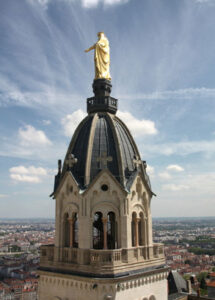Marist Spirituality: An Introduction

Fr David Kennerley SM
Spirituality:
The Gospel Applied to a Time and Place
Setting the Scene
“Jesus said, ‘Imagine a sower going out to sow…’” (Matthew 13:4). Jesus, of course was the Sower himself, and he still is, especially now through his great gift to the Church, the Holy Spirit. This same Holy Spirit, however, God has also ‘let loose’ in the world – and that means, into our lives and times!
There’s a wonderful phrase that recurs throughout the Gospels’ with several variants: “Jesus was passing by” (e.g. John 9:1, but see also Mark 10:46; Luke 19:1;). Jesus is the sower, but he is discreet, inviting but not intrusive. What he sows is the seed of ‘new life’, a deepening of our relationship with Him, his Father and his true family: all those who hear his Word and act on it. Chief among these is Mary His Mother.
Jesus passes by, in and out of our lives, through an array of people and in so many contrasting situations, calling, inviting. Often, it is when life is changing, (or more challenging!) for us, that we will experience his call more tellingly, even urgently: becoming a parent, retiring, reaching a ‘big 0’ birthday, having a teenager!!! At these times the soil lies especially ready and waiting.
What is true for all of us as individuals, also happens in particular historic settings or places. The sower comes, knowing our needs, inviting us to new life. God “is like a householder who brings out from his storeroom, things both new and old” (Matthew 13:52). So it is that the Gospel takes on a ‘new’ form particularly suited to the soil of each passing age. In this way, different spiritualities take shape, come to birth.
Marist spirituality took root in very changing, challenging times, in the soil of the Enlightenment, a wide-ranging movement promoting science and reason with no reference to the Scriptures or to God. One incredible expression of this movement was the French Revolution, seeking mainly to promote personal rights and freedoms, and to give the ‘common man/woman’ justice and protection against the crushing taxes, imposed not only by the Crown, but also by the Catholic Church, which had become so powerful and dominating in France.
One effect of this reaction to the Ancien Regime, the ‘old order,’ was that from 1789–1851, when the Society of Mary was ‘taking shape,’ some seven revolutions or coups erupted in France embroiling the country and the Church. Hence the question arose: How was the Church to engage with this people, in such a turbulent time when men and women were so determined to forgo the old, including the Church as they had come to know it?
The answer that came to a small group of seminarians in the city of Lyon was that the person of Mary, mother of Christ and Mother of the Church, modelled precisely a very different way to be with people and to reach out to others across the whole spectrum of faith in such turbulent times.
The Call to Marists Today
1. To discern the needs of the world in order to bring to it the response of the Gospel.
2. In continuity with the formational experiences of the first Marists, to realise the joy that comes from a whole-hearted response to their vocation in the Church.
A Prayer to Mary
May, Mother of God and Mother of the Church, may we always have confidence in your concern for the pilgrim People of God, the church of your Son.
May we, as Marists, in our own lives, in our homes and in our work, always think and act so as to give great glory to God, and honour to you, our Mother. Amen
An Insight
“Cardinal Castracane in Rome declared, ‘Fr. Colin is a saint. He has understood his era.’ If ever Colin gets canonised, I hope this is what they write: Colin, whose holiness consisted in understanding his era and not in turning away from it, who sought the means to touch it, to heal it, to convert it. He did not turn his back on his era, but tried to imagine a kind of presence, ‘unknown and hidden,’ which enables us to be there, as close as possible, at the very core of what is in peoples hearts.”
Jean Coste SM, A Marian Vision of the Church, p.338
A contemporary Marist writes:
“The heart of modern civilisation is not its refusal of the transcendent but its sacred conviction of freedom. Leaving behind attitudes of rejection and condemnation we must look for the seeds of the Word, and preach the Gospel to this age and world as it is. Only openness, discernment and attentiveness will help us, in listening and dialogue, to discover that men and women today are in fact looking for spiritual values, sometimes in unexpected ways. By genuine conversation and mutual respect within the Church itself, we can help people, or rather each individual, to discover in his or herself, the space that only God can fill.”
Jan Snijders SM, The Age of Mary, p 82ff
QUESTIONS TO PONDER
1. Where are you with God?
What seed of ‘new life’ has God perhaps planted in your thoughts and hopes?
2. What passage or scene do you find most inspiring, comforting, challenging in the Gospel?
3. How helpful to you is it to think of spirituality as the Gospel reshaped for a certain age?
Fourvière:
Responding to a deep attraction

19th century Fourvière
Fourvière: - Chapel of the Virgin
23 July 1816
During the academic year of 1815-16, at the St. Irenaeus seminary in Lyons France, some students began meeting to discuss an inspiration received by one of them at the cathedral of Le Puy, three years earlier in 1812. At the time, these first ‘Marist’ seminarians were still approaching major orders – diaconate or priesthood. They were essentially young men with a sense of being drawn closer to Christ and a growing desire to be serving the Church.
Each was quite taken by the deep attraction of Mary as an inspiration and model for being with others, especially the ‘unchurched.’ So great was this attraction for the individuals and the group that twelve of them decided to pledge themselves to fulfilling the inspiration. This they did on July 23, 1816 in the Chapel of the Virgin on the hill of Fourvière, overlooking Lyon. Several of these first Marists would go on to make the substance of this inspiration the chief work of their lives.
In essence, the recipient of the inspiration, Jean-Claude Courveille, had been cured of near-total blindness at the Cathedral of Le Puy in 1809. At the time, he attributed his cure to Mary the blessed Mother and it was only because of the restoration of his eyesight that Courveille was then able to enter the seminary in Lyons.
On his annual pilgrimage back to the cathedral in 1812, Courveille heard interiorly, but distinctly: This is what I want… I follow my Son in the work he does for his church on earth… In this age of unbelief… it is my wish and the wish of my Son, that there be a Society consecrated to me, which bears my name and calls itself the Society of Mary and its members Marists.
What struck the seminarians with whom Courveille shared his story was the fact that in the long history of the Church, no congregation had ever chosen the name ‘Society of Mary’ until then. It was as if the name had been held in reserve for them and this turbulent “age of unbelief!” Indeed, they were acutely aware that they in fact had not chosen the name at all but had been given it, had been chosen as it were to bear it.
What stayed most with them, however, was the image of Mary intervening, drawing them into doing her work of being a ‘support of the Church.’ With this inspiration then, Mary as it were, emerged from the background in one person’s story to reveal a mission for anyone who similarly came to have a deep attraction to Mary and the work of outreach at a time when faith was being undermined, lost.
Early in their seminary discussions, the first Marists realised that a tree with several branches was needed to encompass laity, religious brothers and sisters, as well as priests because so urgent and diverse was the work. Mary indeed, wanted something – through them! And that still remains the case today.
The Call of Fourvière: for Marists Today
1. To make their own the concern of Mary for the church of their time and to become closely identified with the local church.
2. To see in Mary their way of living the Gospel for today.
A Prayer to Mary
Mary, teach me to do whatever Jesus, your Son, tells me, and pray that like you, may my life “magnify the Lord and my spirit rejoice in God my Saviour”
May the Holy Spirit unite my soul to yours vibrating with the Father’s love for his eternal Son; and make me one ,through you, with Christ in His eternal song of glory, “Hallowed be Thy Name.”
Fourvière: is a ‘defining event’ because the young seminarians came to see in the ‘inspiration of Le Puy,’ the nucleus of a vision that they could eagerly commit themselves to.
A contemporary Marist writes:
“For the first time in history a Religious Congregation appears in the Church, drawing its inspiration not from Mary in herself, seen as the embodiment of all the great virtues, but Mary seen always in relationship: to Jesus, to the Church, and to the contemporary world. It was a very simple and clear idea: what would happen if a group of people built their way of thinking and acting round the model of Mary’s presence in the Church?”
Craig Larkin, A Certain Way, p.40

Our Lady of Fourviere
 Entries(RSS)
Entries(RSS)